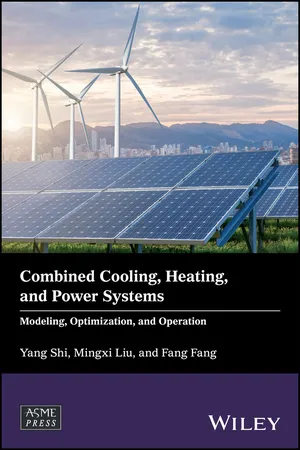
Combined Cooling, Heating, and Power Systems
Modeling, Optimization, and Operation
- English
- ePUB (mobile friendly)
- Available on iOS & Android
Combined Cooling, Heating, and Power Systems
Modeling, Optimization, and Operation
About this book
A comprehensive review of state-of-the-art CCHP modeling, optimization, and operation theory and practice
This book was written by an international author team at the forefront of combined cooling, heating, and power (CCHP) systems R&D. It offers systematic coverage of state-of-the-art mathematical modeling, structure optimization, and CCHP system operation, supplemented with numerous illustrative case studies and examples.
CCHP systems are an exciting emerging energy technology offering significant economic and environmental benefits. Combined Cooling, Heating, and Power Systems: Modelling, Optimization, and Operation is a timely response to ongoing efforts to maximize the efficiency of that technology. It begins with a survey of CCHP systems from the technological and societal perspectives, offering readers a broad and stimulating overview of the field. It then digs down into topics crucial for optimal CCHP operation. Discussions of each topic are carefully structured, walking readers from introduction and background to technical details.A set of new methodologies for the modeling, optimization and control of CCHP systems are presented within a unified framework. And the authors demonstrate innovative solutions to a variety of CCHP systems problems using new approaches to optimal power flow, load forecasting, and system operation design.
- Provides a comprehensive review of state-of-the-art of CCHP system development
- Presents new methodologies for mathematical modeling, optimization, and advanced control
- Combines theoretical rigor with real-world application perspectives
- Features numerous examples demonstrating an array of new design strategies
- Reflects the combined experience of veteran researchers in the field whose contributions are well recognized within the energy community
- Offers excellent background reading for students currently enrolled in the growing number of courses on energy systems at universities worldwide
Timely, authoritative, and offering a balanced presentation of theory and practice, Combined Cooling, Heating, and Power Systems: Modelling, Optimization, and Operation is a valuable resource forresearchers, design practitioners, and graduate students in the areas of control theory, energy management, and energy systems design.
Frequently asked questions
- Essential is ideal for learners and professionals who enjoy exploring a wide range of subjects. Access the Essential Library with 800,000+ trusted titles and best-sellers across business, personal growth, and the humanities. Includes unlimited reading time and Standard Read Aloud voice.
- Complete: Perfect for advanced learners and researchers needing full, unrestricted access. Unlock 1.4M+ books across hundreds of subjects, including academic and specialized titles. The Complete Plan also includes advanced features like Premium Read Aloud and Research Assistant.
Please note we cannot support devices running on iOS 13 and Android 7 or earlier. Learn more about using the app.
Information
Chapter 1
State-of-the-Art of Combined Cooling, Heating, and Power (CCHP) Systems
1.1 Introduction

Table of contents
- Cover
- Title Page
- Copyright
- Dedication
- Table of Contents
- List of Figures
- List of Tables
- Series Preface
- Preface
- Acknowledgment
- Acronyms
- Symbols
- Introduction
- Chapter 1: State-of-the-Art of Combined Cooling, Heating, and Power (CCHP) Systems
- Chapter 2: An Optimal Switching Strategy for Operating CCHP Systems
- Chapter 3: A Balance-Space-Based Operation Strategy for CCHP Systems
- Chapter 4: Energy Hub Modeling and Optimization-Based Operation Strategy for CCHP Systems
- Chapter 5: Short-Term Load Forecasting and Post-Strategy Design for CCHP Systems
- Chapter 6: Complementary Configuration and Operation of a CCHP-ORC System
- Index
- End User License Agreement